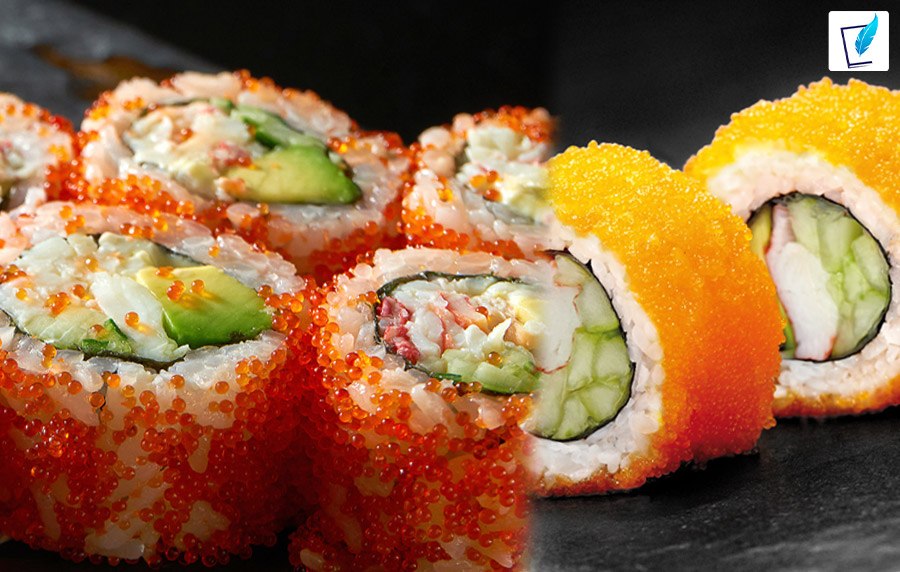Japan, the creator of sushi, is one of the most visited places. Since the Edo period, sushi has been the fast food of the chosen class. Sushi is traditionally made with white rice wrapped in nori.
There are several seafoods used as garnishes. Tobiko and Masago are two of them. But what are the differences between them? They are both rich in nutrients, including omega-3, vitamin B-12, and selenium. So, in this article, let’s uncover the differences between these two fish eggs.
What Is Tobiko?

You must know their properties before learning about Tobiko vs Masago (differences). So, the Japanese term for fish eggs (roe), collected from flying fish, is known as tobiko. The word tobiko (トビウオ) is made from tobiuo. The Japanese sign for tobiou/tobiko is 飛 and 子, which means “flying” and “child.”
The tobiko is a garnish for the sushi rolls (maki). Several salmon roe (iruka) restaurants and street vendors serve it as a main pillar, wrapped in a bed of nori atop nigiri or donburi. Japanese 5-star restaurants or cuisines use dried flying fish to enhance the flavor of dashi or other sushi. If you feel the crunch while eating the sushi, then you can tell that this is tobiko.
What Is Masago?

Now let’s learn, ‘What is masago in sushi?’ The Japanese term for smelt roe is known as Masago, which is collected from the Osmeridae (a family of small silvery fishes). These fish are closely related to salmon and trout. Japanese fishermen collect huge amounts of masago eggs from Hokkaido.
Unlike tobiko, masago is very pocket-friendly and versatile. Street food vendors use masago to replace the expensive tobiko. However, you can tell the difference between these two garnish by the texture and bitterness. Just like tobiko, masago is another common garnish for Japanese sushi rolls. Masago is a very popular garnish for the Komochi shishamo. This is a very delicious dish of Japan that you can eat from head to tell in one bite to feel the burst of flavors.
What Are The Differences Between Tobiko And Masago?

If you are a non-Japanese or a tourist, then you must know the difference between masago and tobiko. These two types of sushi rolls (fish roe) may seem undiagnosable. But there are some major differences between them, which can help you identify the right fish egg. Here are five primary differences between tobiko and masago.
1. Color
The color of the tobiko is golden. On the other hand, Masago has more of a pale yellow color. However, chefs often use artificial colors or dye the ingredients to enhance flavor. Bright orange is the most commonly used artificial color. In wasabi, they dye it a green or black color using squid ink, yuzu, or other citrus fruits.
2. Fish Species
The tobiko is harvested from the flying fish roe, which is similar to salmon roe. This means it contains a high amount of phospholipid fats, which are healthy for the heart and liver.
Masago, or the smelt roe, comes from the capelin fish. These are common fish found in the North Atlantic, North Pacific, and Arctic oceans. The capelin fish is a member of the smelt family.
3. Size
This is one of the major differences between these two fish roes. Tobiko eggs are smaller than a dime (0.5 to 0.8 mm in diameter). The smelt roe eggs are usually 1mm in size.
4. Texture
Tobiko has a crunchy texture. When you eat tobiko egg sushi, you can get a satisfying pop. The flavor of tobiko is salty and sweet, which is best for garnishing. But the masago has a softer texture and is slightly crisp. The flavors are salty, which makes it a perfect appetizer.
5. Price
The biggest difference between these two fish eggs is their price. Tobiko is a little more expensive than Masago. However, they are both available in most Asian sorcery stores (sushi ingredient stores).
What Is Ikura?

Now you know the difference between flying fish roe and smelt roe, but there is another type of fish egg. Ikura is a red-colored, pearl-shaped egg. Ikura comes from the Russian word ikra (икра). This is the most expensive and largest of those two eggs. The soft texture of Ikura is responsible for its melting flavor. To express the flavors, chefs marinate ikura in salt water or soy sauce.
Ikura is a luxury food harvested from salmon. Native Japanese called it “Japanese Caviar” due to its high price and rich quality. Just like tobiko, ikura is also used as a garnish to enhance the flavor of a dish (Japanese sushi). The common use of ikura is in gunkan-style sushi wrapped in nori. The best part about ikura is that you can refrigerate these eggs for up to 7 days.
Conclusion: Wish Fish Roe Is Better?

In the end, there are several fish roes in Japan you can eat, including Ikura, Tarako, Kazunoko, Mentaiko, and sea urchins. However, tobiko and masago are commonly used as fish roe to garnish sushi or appetizers. But if you want something expensive then you can try Red caviar (ikura) or the Beluga caviar.
The Beluga caviar is one of the most expensive fish eggs in the world. An average female fish takes around 15 years to produce Beluga eggs. If you have any other questions regarding this topic feel free to ask me in the comment section. Also, read these informative articles below…
Additional:
- What Is Tamilyogi?
- Seint Makeup Review 2023: Before And After
- 5 Things You Have To Know About Kanye West New Wife



where to buy motilium without a prescription – flexeril pill flexeril price
Your comment is awaiting moderation.